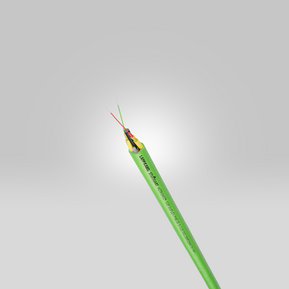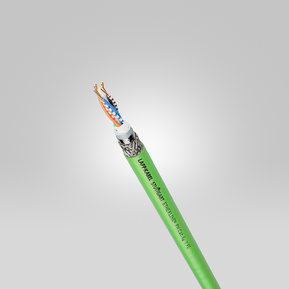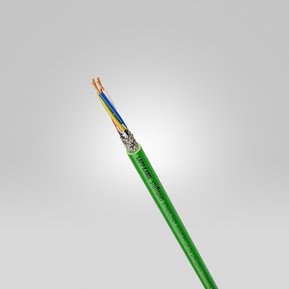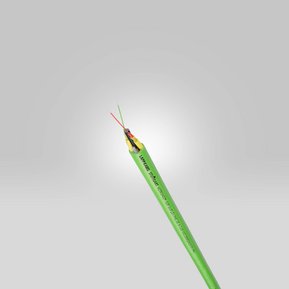Industrial communication with PROFINET

PROFINET is more than just a data transmission protocol based on Ethernet technology. It is a standard that establishes high-performance networks and as a result enables efficient automation in smart factories. PROFINET is a must in an industrial environment. Would you like to find out what data communication with PROFINET looks like, what requirements you need to meet and what you need to keep in mind when selecting a product? We can answer your questions directly in the text below.
Ethernet and PROFINET – easily explained
What is Ethernet?
Ethernet is a data transmission technology for wired networks and is the standard for transmitting data packages in local home or office networks (LAN).
This means that data is sent and received via Ethernet. Ethernet does not work wirelessly like WiFi, but rather is only bundled.
The trade association IEEE has defined and standardised this network protocol and the structure of its packages with IEEE specification 802.3.
Ethernet forms the basic technology for the largest network in the world – the Internet – and is therefore the most commonly used standard in the world.
What is Industrial Ethernet?
However, the properties of the classic Ethernet from building cabling are not sufficient for industrial environments. Data packages should be reliably sent and received in office environments. However, smaller time delays have significant impacts here.
Industrial Ethernet (IE) is used in the industrial sector. With Industrial Ethernet, it is now possible to link the world of the office to the world of industry. This means linking individual machines with the control level, both in production and process automation. Industrial Ethernet allows data packages to be sent and received at the exact time required (determinism). This is because in automation systems with tough real-time requirements, package delays are simply unacceptable and cause serious conflicts.
In addition, the environmental conditions in the industrial sector are much more demanding than in offices. In production, high temperatures and humidity can often be counted on with oil. High dynamic requirements must also be met where cables are constantly moved. The components used must be sufficiently robust in order to function permanently and reliably here.
The entire system should also be so simple to use that it can be planned, installed and maintained by non-IT experts, i.e. automation engineers.
And how does PROFINET fit in?
PROFINET (Process Field Network) is a data transmission standard based on the Industrial Ethernet protocol. It is a special communication system that is ideal for use in industrial networks and is a leading player in Europe.
PROFINET is suitable for all automation technology and can be used in any industry.
Whereas Industrial Ethernet only governs the requirements of the data transmission protocol, the PROFINET standard describes more than just data transmission. The standard also includes statements regarding the permissible design and colour of cable outer sheaths and cores, defines plug connector faces and much more.
Incidentally, PROFINET is not to be confused with the very similar PROFIBUS, the protocol standard for Fieldbus communication.
PROFINET – Generation and standardisation
The industrial Ethernet system PROFINET was developed by Siemens AG together with the PROFIBUS & PROFINET User Organisation (PNO). This user organisation is now active worldwide and has hundreds of members.
LAPP also plays an active role in the respective working groups.
The PROFINET system is specified internationally in IEC 61918 'Industrial communication networks – Installation of communication networks in industrial premises' for cabling within and between automation islands and/or production islands. The specific infrastructure for PROFINET cabling and connection solutions is standardised in turn in IEC 61784-5-3. This applies for copper-based and fibre optic transmission media and wireless transmission. The 'PROFINET Cabling and Interconnection Technology Guideline' is created by a working group within the PNO. This guideline reflects IEC 61784-5-3.
What benefits does PROFINET offer?
PROFINET combines the benefits of many other protocol standards:
- 100% Ethernet compatibility
- Flexibility in terms of functionality thanks to the modular design according to conformity classes
- Interoperability of PROFINET-compliant components thanks to standardisation
- Easily expandable systems
- Easy integration of Fieldbus systems
- Highly available systems
- Low maintenance requirement of the network
- Tried-and-tested safety and diagnostic concepts
- Scalable real-time communication
- Components with certification guarantee a high level of system reliability
Which PROFINET variants are available?
The most favoured PROFINET system is PROFINET IO (input/output) from 2006. The PROFINET IO communication system has a modular design and can be set up in various variants. The varying scope of functions enable a corporate network to be designed in a variety of ways. As every automation system sets its own requirements for data transmission, the system operator decides which functionality is required based on so-called conformity classes.
What different Conformance Classes does PROFINET offer?
The possible applications are divided into four conformity classes, which determine, for example, the device types to be used (controller, device, supervisor), the transmission medium used and the type of communication. This ensures that the components of a class are always compatible and meet the necessary requirements. A class supplements the functional scope of the class below with other functionalities.
Conformity classes at a glance:
| Conformance Class | Transmission medium used | Typical possible uses | Examples of scope of function |
|---|---|---|---|
| CC-A |
Copper conductor Fibre optic cables Wireless | For infrastructure networks and building automation |
|
| CC-B | Copper conductors and fibre optic cables | For factory and process automation |
|
| CC-C | Copper conductors and fibre optic cables | For motion control applications |
|
| CC-D | Copper conductors and fibre optic cables | For various applications |
|
Note: When selecting your components, make sure they match the Conformance Class you have selected for your automation system.
How is the cabling performed in the PROFINET network?
The guideline for PROFINET specifies the structure as well as the mechanical and electrical properties of copper cables, copper hybrid cables and fibre optic cables that can be used in PROFINET networks. Depending on the type of cable, this also includes requirements regarding
- cable marking,
- core identification colours,
- shielding type,
- outer sheath colour,
- resistance values,
- attenuation values,
- frequency ranges,
- temperature resistance,
- flame retardance and much more.
Which cables are suitable for PROFINET?
Specification connectors for copper cables
Four cable types have been defined for copper cables, for both 2- and 4-pair cables.
Requirements for copper cables (signal transmission only) at a glance:
| Cable type | Installation | Conductor | Design |
|---|---|---|---|
|
Type A |
| Solid conductor |
2-pair: AWG22/1 4-pair: min. AWG23/1 |
| Type B |
| Flexible stranded conductor, 7-wire |
2-pair: AWG22/7 4-pair: min. AWG23/7 |
| Type C |
| Solid wire or flexible stranded conductor, up to 19-wire |
2-pair: AWG22/1 … 19 4-pair: min. AWG24/1 … 19 |
| Type R |
| Solid wire or flexible stranded conductor, up to 19-wire | 2-pair: AWG22/1 … 19 |

In addition to the symmetrical cable design, PROFINET also allows hybrid cable designs (type B and C) like our ETHERLINE® Cat.5 FRNC HYBRID (type B). Hybrid cables contain cores for signal transmission and power supply.
Fast Connect for PROFINET
Many of our PROFINET data cables have a “Fast Connect” structure with a special inner sheath and a cross separator instead of shielded core pairs (identifiable by FC in the product name). This means that when assembling the data cable with a suitable connector, there is no need for otherwise complicated removal of the pair shielding.
A Fast Connect system is a holistic solution, from the cable to the connector solution to the right tool.
With FC products you save up to 50% of the time when assembling your data cable. It doesn't just sound great. It is.
Find out how uncomplicated the Fast Connect system is and how much faster you can use it to carry out the cable assembly.
Fibre optic cables specification
For POF, PCF and GOF fibre optic cables, two cable types have been identified.
The requirements for fibre optic cables (optical signal transmission) at a glance:
| Cable type | Installation | Design | Diameter of core/sheath |
|---|---|---|---|
| Type B |
|
|
POF: 980/1000 µm PCF: 200/230 µm GOF singlemode: 9/125 µm GOF multimode: 50/125 µm or 62.5/125 µm |
| Type C |
|
|
POF: 980/1000 µm PCF: 200/230 µm GOF singlemode: 9/125 µm GOF multimode: 50/125 µm or 62.5/125 µm |
Everything in the green?
Incidentally, the colour of the outer sheath of PROFINET cables is fixed and is a pretty clear identification feature (at least for type A and type B cables): green RAL6018.
It is the preferred choice for type C and type R.
Which plug connectors are suitable for PROFINET?
The PROFINET guideline specifies various plug connector types for the connection technology – both for cabling in protected areas such as in the control cabinet, where a lower protection rating is required, and for cabling in the field with more demanding requirements for dirt and moisture-resistant plug connectors.
Specification for copper connectors
Two standards have been established for copper plug connectors with respect to the data transmission from industrial Ethernet in the PROFINET system – RJ45 and M12.
The plug connector requirements for copper cables at a glance:

| Connector type | Plug connector class | Protection rating | Connector face | Transmission rate |
|---|---|---|---|---|
| RJ45 | For protected areas | IP 20 | For 2 and 4-pair cables |
up to 100 Mbit/s up to 10 Gbit/s |
| M12 D-coded | For applications in the field | IP 67 | for 2-pair cables | up to 100 Mbit/s |
| M12 X-coded | For applications in the field | IP 67 | for 4-pair cables | up to 10 Gbit/s |
With respect to field-configurable plug connectors, the main focus should be on ensuring that the connection process is as easy as possible and performed without the use of special tools where possible. In addition, the plug connectors should be able to connect to as many cables as possible. This means that they cover a broad spectrum of conductor cross-sections and diameters, conductor stranding and external cable diameters.
Specification for fibre optic cable plug connectors
The following standards have been established for optical plug connectors with respect to the data transmission from industrial Ethernet in the PROFINET system.

The plug connector requirements for fibre optic cables at a glance:
| Connector type | Plug connector class | Protection rating | Fibre type |
|---|---|---|---|
| SC-RJ | For protected areas | IP 20 | For POF, PCF |
| ST | For protected areas | IP 20 | For POF, PCF, but only for existing installations |
| LC DUPLEX | For protected areas | IP 20 | For GOF |
Want more?
From 4-core or 8-core PROFINET cables from the ETHERLINE® brand to fibre optic cables featuring POF, PCF or GOF variants from our HITRONIC® range, the LAPP Group has the right cabling solution for your PROFINET application. Below are some highlights from our online shop:
Copper cables
For fixed installation in the PROFINET® network (type A): Thanks to its Fast Connect design with a cross separator between the pairs of wires, the UL-certified Ethernet cable (Cat. 6A) can be assembled very quickly and at the same time impresses with its outstanding EMC properties. Choose from three different sheath materials.
For robot applications, rely on our Industrial Ethernet cable, which has been developed and tested according to the uniform PROFINET-Standard "Type R". Cable chain, torsion and alternating bending properties are now combined in just one cable. LAPP was involved in developing and standardising the requirements for this PROFINET network class from the outset.
ETHERLINE® Cat.5 cables for PROFINET applications
Fibre optic cables
The product name says it all: glass fibre + PROFINET + building installation in one! The highly flame-retardant breakout cable is ideal for control cabinets and structured building cabling within PROFINET networks. The individual cables both inside and outer sheath convince with their halogen-free materials.
The product name stands for glass fibre + PROFINET + permanent movement in one! The breakout cable combines cable chain, torsion and alternating bending properties, making it ideal for moving applications, vibration or torsion within PROFINET networks. Thanks to the PU cable insulation, the product is particularly durable and robust.
HITRONIC® POF cables for PROFINET applications
HITRONIC® PCF cables for PROFINET applications





